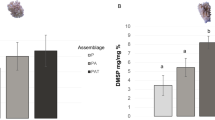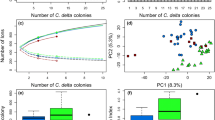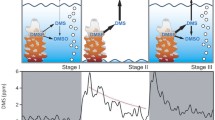Abstract
Dimethylsulfoniopropionate (DMSP) is an important component of the global sulfur cycle and may be involved, via its cleavage product dimethylsulfide, in climate regulation. Although it is common in many algae, reports of DMSP in animals, particularly tropical invertebrates, are limited. This study examined the distribution of DMSP in a diverse group of coral reef invertebrates. DMSP was present in all 22 species of cnidarians and ranged from 9 to 723 μmol g−1 of dry mass (DM) with a mean (± 1SD) of 110 ± 180 μmol g−1 DM. It was not detected in a flatworm and an ascidian or in two of five sponges. Concentrations in sponges ranged from undetectable to 16 μmol g−1 DM with a mean of 4 ± 7 μmol g−1 DM. Within the cnidarians, DMSP concentrations did not differ among orders. Among cnidarian species, DMSP concentrations were correlated with symbiotic zooxanthellae densities. Within cnidarian species, DMSP concentrations of individuals were positively correlated with zooxanthellae densities in three of the four species examined. We speculate that DMSP is dietarily derived in sponges and derived from zooxanthellae in the cnidarians. The functions of DMSP in coral reef invertebrates are not known.

Similar content being viewed by others
References
Ackman R, Hingley J, MacKay K (1972) Dimethyl sulfide as an odor component in Nova Scotia fall mackerel. J Fish Res Board Can 29:1085–1088
Andreae MO, Barnard W, Ammons J (1983) The biological production of dimethylsulfide in the ocean and its role in the global atmospheric sulfur budget. Ecol Bull 35:167–177
Baker A (2003) Flexibility and specificity in coral–algal symbiosis: diversity, ecology, and biogeography of Symbiodinium. Ann Rev Ecol Syst 34:661–689
Broadbent A, Jones G (2004) DMS and DMSP in mucus ropes, coral mucus, surface films and sediment pore waters from coral reefs in the Great Barrier Reef. Mar Freshwater Res 55:849–855
Broadbent A, Jones G, Jones R (2002) DMSP in corals and benthic algae from the Great Barrier Reef. Estuar Coast Shelf S 55:547–555
Charlson RJ, Lovelock JE, Andreae MO, Warren SG (1987) Oceanic phytoplankton, atmospheric sulphur, cloud albedo and climate. Nature 326:655–661
Coffroth M, Santos S, Goulet T (2001) Early ontogentic expression of specificity in a cnidarian-algal symbiosis. Mar Ecol-Prog Ser 222:85–96
Edwards DM, Reed RH, Chudek JA, Foster R, Stewart WDP (1987) Organic solute accumulation in osmotically-stressed Enteromorpha intestinalis. Mar Biol 95:583–592
Edwards DM, Reed RH, Stewart WDP (1988) Osmoacclimation in Enteromorpha intestinalis: long-term effects of osmotic stress on organic solute accumulation. Mar Biol 88:457–476
Fagoonee I, Wilson H, Hassell M, Turner J (1999) The dynamics of zooxanthellae populations:a long-term study in the field. Science 283:843–845
Hill RW, Dacey JWH, Krupp DA (1995) Dimethylsulfoniopropionate in reef corals. B Mar Sci 57:489–494
Hill RW, Dacey JWH, Edward A (2000) Dimethylsulfoniopropionate in giant clams (Tridacnidae). Biol Bull 199:108–115
Hirose M, Kinzie RAI, Hidaka M (2000) early development of zooxanthella-containing eggs of the corals Pocillopra verrucosa and P. eydouxi with special reference to the ditribution of zooxanthellae. Biol Bull 199:68–75
Jones G, Trevena A (2005) The influence of coral reefs on atmospheric dimethylslphide over the Great Barrier Reef, Coral Sea, Gulf of Papua and Solomon and Bismark Seas. Mar Freshwater Res 56:85–93
Jones GB, Curran MAB, Broadbent AD (1994) Dimethylsulphide in the South Pacific. In: Bellwood O, Choat H, Saxena N (eds) Recent advances in marine science and technology 94. Proceedings of the 6th Pacific congress on marine science and technology, Townsville, 1994. James Cook University Press, Townsville, pp 183–190
Karsten U, Wiencke C, Kirst GO (1991) Growth pattern and beta-dimethylsulfoniopropionate (DMSP) content of marine macroalgae at different irradiances. Mar Biol 108:151–155
Karsten U, Wiencke C, Kirst GO (1992) Dimethylsulphoniopropionate (DMSP) accumulation in green macroalgae from polar to temperate regions: interactive effects of light versus salinity and light versus temperature. Polar Biol 12:603–607
Karsten U, Kuck K, Daniel C, Wiencke C, Kirst GO (1994) A method for complete determination of dimethylsulfoniopropionate (DMSP) in marine macroalgae for different geographical regions. Phycologia 33:171–176
Kiene RP, Visscher P, Keller M, Kirst GO (1996) Biological and environmental chemistry of DMSP and related sulfonium compounds. Plenum Press, New York
Kirst GO, Thiel C, Wolff H, Nothnagel J, Wanzek M, Ulmke R (1991) Dimethylsulphoniopropionate (DMSP) in ice-algae and its possible biological role. Mar Chem 35:381–388
Knowlton N, Rohwer F (2003) Multispecies microbial mutualisms: the host as habitat. Am Nat 162:S51–S62
Kozloff E (1990) Invertebrates. Saunders, Philadelphia
Lesser MP, Stochaj WR, Tapley DW, Shick JM (1990) Bleaching in coral reef anthozoans: effects of irradiance, ultraviolet radiation, and temperature on the activities of protective enzymes against active oxygen. Coral Reefs 8:225–232
Levasseur M, Keller MD, Bonneau E, D’Amours D, Bellows WK (1994) Oceanographic basis of a DMS-related Atlantic cod (Gadus morhua) fishery problem: blackberry feed. Can J Fish Aquat Sci 51:881–889
Lewis C, Coffroth M (2004) The acquisition of exogenous algal symbionts by an octocoral after bleaching. Science 304:1490–1494
Malin G, Kirst GO (1997) Algal production of dimethyl sulfide and its atmospheric role. J Phycol 33:889–896
Malin G, Turner SM, Liss PS (1992) Sulfur: the plankton/climate connection. J Phycol 28:590–597
Pasternak Z, Bachar A, Abelson A, Achituv Y (2004) Initiation of symbiosis between the soft coral Heteroxenia fuscesens and its zooxanthellae. Mar Ecol-Prog Ser 279:113–116
Reed RH (1983a) Measurement and osmotic significance of beta-dimethylsulfoniopropionate in marine macroalgae. Mar Biol Lett 4:173–181
Reed RH (1983b) The osmotic responses of Polysiphonia lanosa (L.) Tandy from marine and estuarine sites: evidence for incomplete recovery of turgor. J Exp Mar Biol Ecol 68:169–193
Rowan R (1998) Diversity and ecology of zooxanthellae on coral reefs. J Phycol 34:407–417
Rowan R, Knowlton N, Baker A, Jara J (1997) Landscape ecology of algal symbionts creates variation in episodes of coral bleaching. Nature 388:265–269
Schwarz J, Weis V, Potts D (2002) Feeding behavior and acquisition of zooxanthellae by planula larvae of the sea anemone Anthopleura elegantissima. Mar Biol 140:471–478
Stefels J, Dijkhuizen L (1996) Characteristics of DMSP-lyase in Phaeocystis sp. (Prymnesiophyceae). Mar Ecol-Prog Ser 131:307–313
Sunda WG, Kieber D, Kiene R, Huntsman S (2002) An antioxidant function for DMSP and DMS in marine algae. Nature 418:317–320
Van Alstyne KL, Houser LT (2003) Dimethylsulfide release during macroinvertebrate grazing and its role as an activated chemical defense. Mar Ecol-Prog Ser 250:175–181
Van Alstyne KL, Wylie CR, Paul VJ, Meyer K (1992) Antipredator defenses in tropical Pacific soft corals (Coelenterata: Alcyonaria). I. Sclerites as defenses against generalist carnivorous fishes. Biol Bull 182:231–240
Van Alstyne KL, Wolfe GV, Freidenburg TL, Neill A, Hicken C (2001) Activated defense systems in marine macroalgae: evidence for an ecological role for DMSP cleavage. Mar Ecol-Prog Ser 213:53–65
Van Alstyne KL, Pelletreau KN, Rosario K (2003) The effects of salinity on dimethylsulfoniopropionate production in the green alga Ulva fenestrata Postels et Ruprecht (Chlorophyta). Bot Mar 46:350–356
Van Bergeijk SA, Stal LJ (2001) Dimethylsulfoniopropionate and dimethylsulfide in the marine flatworm Convoluta roscoffensis and its algal symbiont. Mar Biol 138:209–216
Vincent WF, Neale PJ (2000) Mechanisms of UV damage to aquatic organisms. In: de Mora S, Demers S, Vernet M (eds) The effects of UV radiation in the marine environment. Cambridge University Press, Cambridge, pp 149–176
Weis V, Reynolds W, deBoer M, Krupp D (2001) Host-symbiont specificity during onset of symbiosis between the dinoflagellates Symbiodinium spp. and planula larvae of the scleractinian coral Fungia scutaria. Coral Reefs 20:301–308
White B, Hill RW, Dacey JWH (1995) Accumulation of dimethylsulfoniopropionate in Geukensia demissa depends on trophic interactions. Biol Bull 189:235–236
Wolfe GV, Steinke M (1996) Grazing-activated production of dimethyl sulfide (DMS) by two clones of Emiliania huxleyi. Limnol Oceanogr 41:1151–1160
Wolfe GV, Steinke M, Kirst GO (1997) Grazing-activated chemical defence in a unicellular marine alga. Nature 387:894–897
Acknowledgments
We thank University of Guam Marine Laboratory (UOGML) students for assistance in the field and for their efforts to locate trucks for the Cocos Lagoon trips, T. Rongo and M. McCormick for identifying corals, M. McCormick for providing Leptastrea larvae and G. Jones, and an anonymous reviewer for their many helpful comments on this manuscript. We are also grateful to the staff at the UOGML for the logistical support that they provided for this project. This work was funded by National Science Foundation grants IBN-0090825 and DBI-9877129 to K. Van Alstyne and National Oceanic and Atmospheric Administration NURP/NIUST NA 16RU1496 to M. Slattery. P. Schupp acknowledges support by the National Institutes of Health MBRS SCORE S06-GM44796-15 for ongoing support and laboratory infrastructure.
Author information
Authors and Affiliations
Corresponding author
Additional information
Communicated by Environment Editor K. Fabricius
Rights and permissions
About this article
Cite this article
Van Alstyne, K.L., Schupp, P. & Slattery, M. The distribution of dimethylsulfoniopropionate in tropical Pacific coral reef invertebrates. Coral Reefs 25, 321–327 (2006). https://doi.org/10.1007/s00338-006-0114-9
Received:
Accepted:
Published:
Issue Date:
DOI: https://doi.org/10.1007/s00338-006-0114-9




